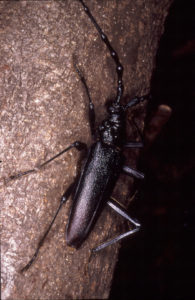Species and habitat description
This beetle measures between 41 and 55 mm in body length and is among the largest of the European beetle species. In males, the thread-like antennae are longer than the body, but in females they are only as long as the hard wing cases (the elytra). The legs and body are black, except for the elytra which are reddish-brown towards the tips. This is an obligate saproxylic species, and is ecologically associated with old individuals of different oak species. Larval development lasts a minimum of three years and takes place in wood that is still fresh. No dead oaks are colonised while weakened oaks are probably preferred. Colonisation in central Europe appears exclusively on oaks larger than 60 cm in diameter at breast height (DBH) and larval development is favoured by increasing trunk insulation.
Major threats
Long-term survival of populations is dependent on a network of a sufficient number of old oaks in a given region. This species is particularly affected by changes in habitat and landscape structure due to intensification in land use by agriculture and forestry. A possible long-term threat may be increasing isolation between subpopulations, because dispersal ability of most individuals is limited to a few hundred meters. The disappearance of old, large oak trees is a major threat to the species.
Specific conservation action
Support of the oversized, old oak tree individuals in the canopy layer. Making barkless patches on the stem of large, old oak trees. Creating sunlit gaps near the oversized, old oak trees with wounded trunk.

Related project areas
Börzsöny-Diósjenő
Carnè e Rontana, Locatilà Gesso, Monte Penzola, Monte Mauro, Riva di San Biagio